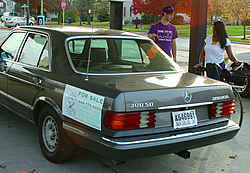|
Issue Contents :: Feature :: Bio D :: [ 1 2 ]
Bio D
Biodiesel Project a Stepping Stone
toward Renewable Energy Economy
by Tim Tibbits
|
Full Circle Fuels, Oberlin’s first alternative fuel station, is the brainchild of environmental studies major Sam Merrett ’05 (center in photo). He and mechanics Ian Warren and Bob Beckett have had a steady stream of customers—one from as far away as Connecticut—wanting their vehicles converted to run on biodiesel or vegetable oil. |
When fuel deliveries were disrupted in the aftermath of Hurricane Katrina in September, the public transportation authority in Cincinnati, Ohio, announced that its 390 buses would be run on a mixture of 70 percent diesel fuel and 30 percent biodiesel, which is essentially chemically altered vegetable oil. Biodiesel is widely accepted as a cleaner-burning alternative to fossil fuels and can be used on its own or mixed at any percentage with standard diesel fuel to power diesel engines.
Two hundred miles to the north, a group of Oberlin students, led by Sam Merrett ’05 and supervised by Kathryn Janda, assistant professor of environmental studies, had already been working for several years to make biodiesel a household word. In fact, since January 2003, the group has involved an increasing number of students and community members in making and using their own biodiesel fuel from an unlikely source: waste oil garnered from grease fryers at local restaurants.
“Despite widespread use, petroleum-based fuels are not environmentally safe, geopolitically secure, or affordable,” Janda says. “Diesel fuel consumption pollutes the air, drains communities of revenue, and places disproportionately high costs on low-income community members.”
Clearly our society must seriously explore alternative sources of energy. But how?
Merrett and his cohorts have not deluded themselves into thinking that biodiesel is the fuel of the future. It’s unlikely that any one fuel will play that role. However, he and Janda quickly point out that the education provided by getting people involved in making their own fuel might play a small role in nudging us—one community at a time—toward the inevitable transformation from our fossil fuel-driven infrastructure to one based on renewable energy sources.
 An Accidental Passion An Accidental Passion
Grinding it out in the classroom was never Sam Merrett’s forte as a student. A graduate of Buxton, a progressive school in Williamstown, Massachusetts, Merrett came to Oberlin in the fall of 2001 partly because he knew he could obtain academic credit for work done outside the classroom.
This motivation, he admits, and not a passion for energy issues, first got him involved with the Oberlin Design Initiative (ODI), a non-profit organization founded by Oberlin graduates with the aim of “connecting community ideas, needs, and issues with the energy and expertise of Oberlin College students.”
At the time ODI was exploring ways to use technology to address the complex problems surrounding energy use. As a first-year student volunteering with ODI, Merrett became intrigued with energy.
The next fall, Merrett took Janda’s Energy and Society course and in no time was hooked. For the final project, he and Avery Book ’04 initiated what has become an ongoing relationship between environmental studies students and the Oberlin City Schools. Their project’s goal: to integrate energy education into the public school curriculum.
“We approached them with the idea of an after-school class, and it turned out there was a math lab class with a very flexible schedule,” Merrett says. “We were able to work in a three-week mini course teaching math concepts through an energy curriculum.”
Thus was born the Youth Energy Project (YEP!), a student-led initiative in which students and community members work together to design and fund projects to promote renewable energy and energy conservation. Through YEP!, Oberlin middle- and high-school students have wrestled with energy concepts in English papers, geometry classes, and even in a solar cooking unit in a home economics class. For his leadership of this initiative, Merrett was recognized nationally as one of five recipients of the 2005 Howard R. Swearer Student Humanitarian Award.
Turning Vegetable Oil into Gold
Merrett realized the depth of his passion for energy issues just in time for winter term of his sophomore year, which he spent at Hampshire College in Massachusetts with his sister, Molly, and his Hampshire friend Ian Warren. Together, the three built a processor that transformed vegetable oil into a fuel that could be burned in any diesel engine.
The conversion of vegetable oil into biodiesel, a process called “transesterification,” involves five steps: heating, adding chemical reactants, mixing, settling, and separating. Heating the oil does involve some electricity. Due in part to budget constraints, however, the trio developed a creative way of energizing the mixing process “off the grid”: pedal power.
“Honestly, it started as a bit of a joke,” Merrett says. “And then, the more we thought about it, the more it seemed like a great idea—interactive, safe, cheap, renewable energy.”
The result was a bicycle-powered processor that was clunky, difficult to ride, and—because it had been created with Hampshire College research money—stuck in Massachusetts. But by then Merrett had the bug. He was determined to bring biodiesel to Oberlin.
Next Page >>
|





